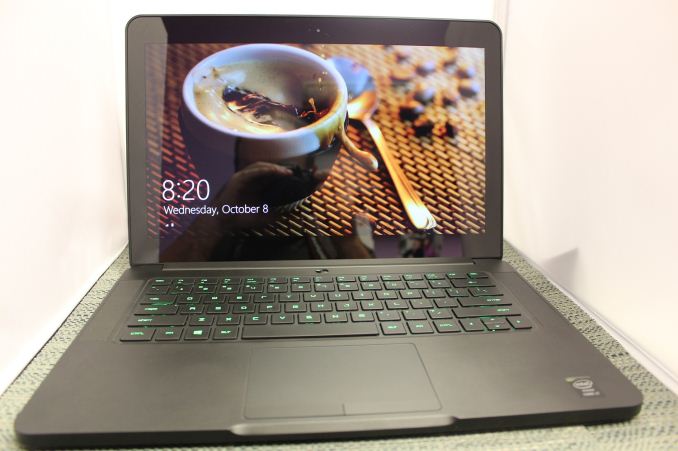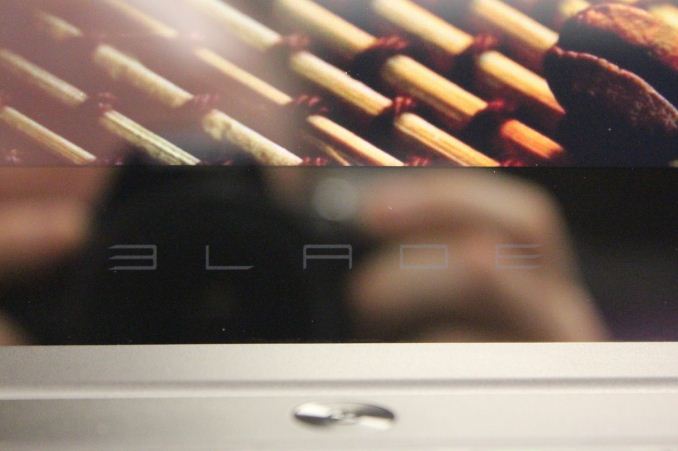The 2014 Razer Blade Review
by Brett Howse on October 10, 2014 9:00 AM EST- Posted in
- Notebooks
- Gaming
- Laptops
- Razer Blade
Final Words
The 2013 Razer Blade was a fantastic notebook computer with an abysmal display. For 2014, Razer has put one of the best displays we have ever tested in a laptop into the Blade, and it truly completes the experience. Razer’s slogan is “For Gamers, by Gamers” and we have to first evaluate the Razer Blade as a gaming laptop. Here it succeeds almost completely.
With a quad-core Intel Core i7 and an NVIDIA GeForce GTX 870M, there is a lot of processing power. The 14 inch Blade runs with larger gaming systems in our benchmarks, and it does all of this without throttling under load. It does get hot, but for the most part it is not hot where you will be touching it.
The high PPI display also looks fantastic when gaming at the native resolution, but the 3200x1800 resolution certainly taxes the available GPU power, and in order to push almost 6 million pixels some of the effects in games will need to be turned down. Luckily this is generally a very easy process for a lot of games due to the GeForce Experience software. If the game you want to play is not in the NVIDIA database though, expect some trial and error to find a frame rate and graphical quality that works for you. Perhaps a 2015 refresh of the system with the GTX 970M will be the solution to this.
If you are looking for a powerful, portable, well-built gaming laptop, you would be hard pressed to find something more pleasing for the task. There are faster systems out there, but they are generally larger and heavier, so you would lose the portability of a 14 inch system. In the past, gaming laptops were meant to move from one table to another, but the Razer Blade has shown that this does not need to be the case.
Portability is one of the biggest aspects of the 2014 Razer Blade. The CNC aluminum body is thin and light. Yet inside is a 70 Wh battery that allows the Blade to be used unplugged from the mains for a reasonable amount of time. Battery life is not record setting, but considering the amount of performance inside and the high PPI display, it is generally adequate.
When you have a system of this quality and price, you have to assume no one is going to buy it just as a system to game on. As a general purpose PC, the Razer Blade is also very good. Performance is very quick due to the Samsung SSD, and the display once again is the star of the show with fantastic color reproduction and great viewing angles. The Blade looks and feels a lot like a 15 inch MacBook Pro, and likely by design.
The two machines both have high resolution displays, strong aluminum bodies, and the size and weight are so close the comparisons are unavoidable. But as a general use laptop, the rMBP does edge the Razer in some key areas. It has a faster CPU, it comes with a default of 512GB PCI-e based SSD, and most importantly it comes with 16GB of memory. The GPU is a much less potent GT 750M though, but for applications that is generally not such a big deal. I would have liked to see Razer bump the memory to 16GB, which would allow the Razer Blade to be used for many more tasks, especially running Virtual Machines.
While I would like to see the 16GB of memory, that does not detract from what is already there. Overall the Razer Blade is a fantastic laptop, with excellent build quality, great acoustics, a powerful CPU and GPU, and now, finally, an amazing display. The 2013 model was well reviewed despite the horrible display, due to the thin and light design. You can see the effort put into the 2014 model to ensure that the mistakes of the last model are rectified, and they certainly are.
The price has crept up a bit over last year though, with the base cost now at $2200 USD. But that is only with 128GB of storage, which really isn't sufficient , so most users will have to jump up to the $2400 USD 256GB model. That's expensive to be sure, but for the money you get one of the best notebooks with one of the best displays money can buy, even several months after launch.












69 Comments
View All Comments
TiGr1982 - Friday, October 10, 2014 - link
Indeed, as a new buy, the unit with Kepler-based GTX 870M became instantly obsolete at the day of release of Maxwell-based GTX 970M.Only an uninformed buyer will buy this now. Or, alternatively, a large discount may help.
TiGr1982 - Friday, October 10, 2014 - link
And 8 GB of RAM for this kind of pricing is not a good offer either.Niavlys77 - Friday, October 10, 2014 - link
Would be great to see a comparison to the Lenovo Y50 - I know it's 1080p screen is terrible, but I'm wondering how the 4k screen holds up to this IGZO panel.Friendly0Fire - Friday, October 10, 2014 - link
I'm fine with my current laptop (Asus UX51), but in a year or two I could see myself upgrading to this. Nvidia's Maxwell will probably make a significant difference on battery life and heat on a machine like this, so I'm excited to see the 2015 refresh.dmunsie - Friday, October 10, 2014 - link
For the gaming performance section, would it be possible to get the rMBP in there as well? Perhaps not OS X, since there is a lot not available on the OS X side. But certainly running Windows 8.1 would be doable and nice to know.frostyfiredude - Friday, October 10, 2014 - link
It has a GT750m, expect around 60% of the performance gotten by the 2013 Blade 14.aferox - Friday, October 10, 2014 - link
Would like to see this compared with the Gigabyte Aorus X3 Plus.frelledstl - Friday, October 10, 2014 - link
I just don't get the fascination with these higher than 1080p displays on a gaming notebook when the hardware just doesn't support that resolution with playable frame rates in newer games. At minimum if you are going to benchmark at 1080p, we need some kind of analysis on how the display handles scaling down to the lower resolution. 14 inches to me is the best size for a portable gaming laptop, but I can't help but think that something like the W230ss is just a better value for the money by far with its still nice 1080p IPS screen.. You can get a decent configuration of that for $1200-$1400 with a nice sized SSD and since the SS version is there 2nd gen version of that laptop, they have included some nice power optimization improvements. I think 2k-4k gaming is great, on a desktop that might stand a chance at actually providing decent frame rates at high detail settings.XabanakFanatik - Sunday, October 12, 2014 - link
I'll tell you from personal experience that I have played games accidentally set to 1080p and did not realize I was not at native resolution. A more thorough analysis of scaling would be nice, but I have no complaints.synaesthetic - Monday, October 20, 2014 - link
I raised this point myself but I noticed the non-standard resolution of 3200x1800. That's exactly four times 1600x900, which *is* a standard resolution. The performance figures at 1080p suggest that this laptop would run most games extremely well at 1600x900 and since the resolution is divisible four times into the native resolution, it shouldn't have any fuzziness or loss of sharpness from interpolation.